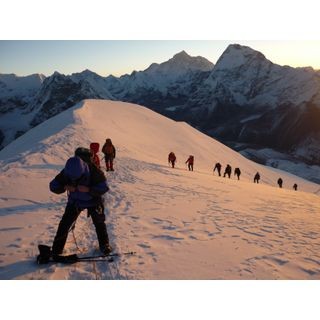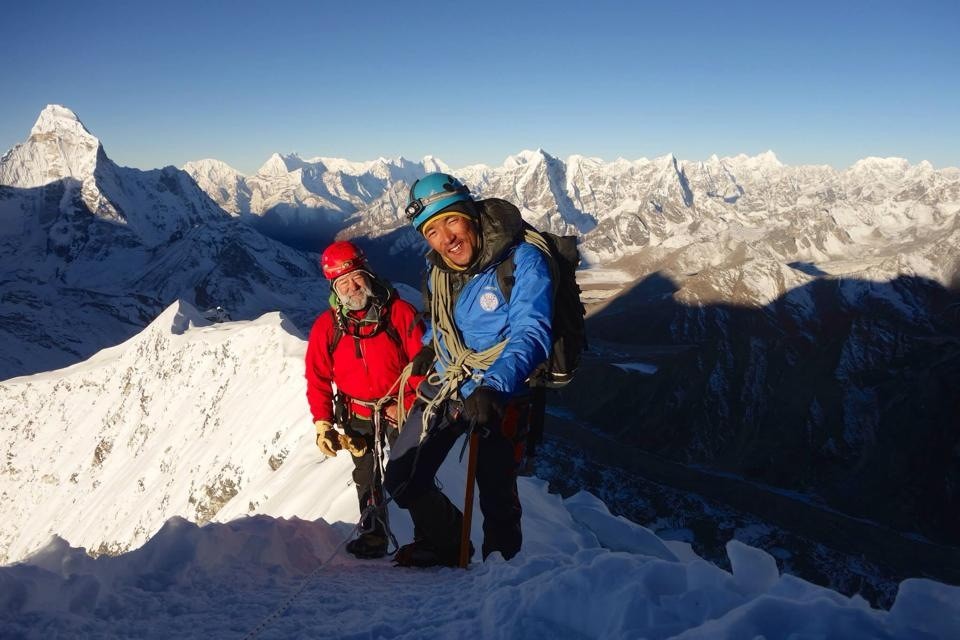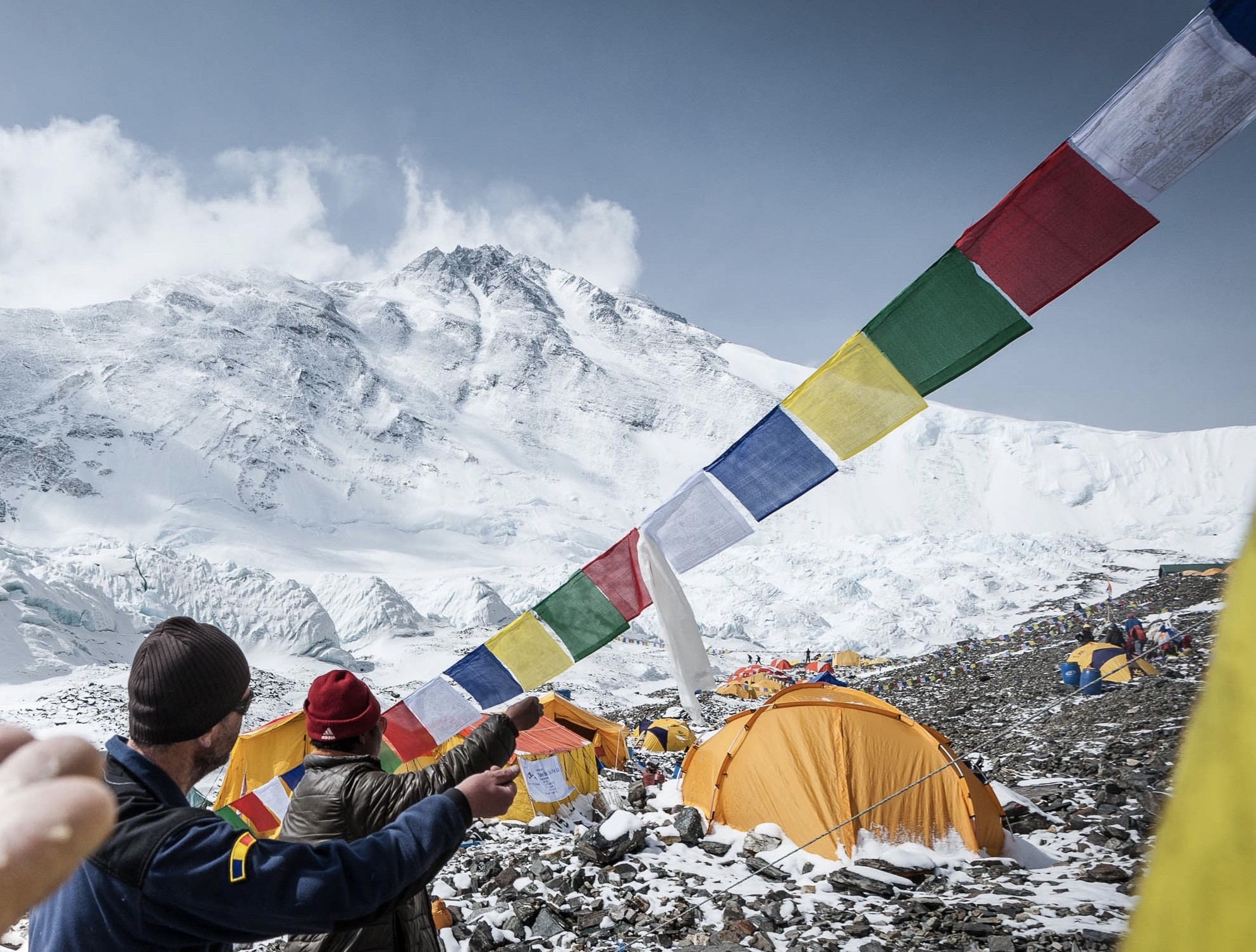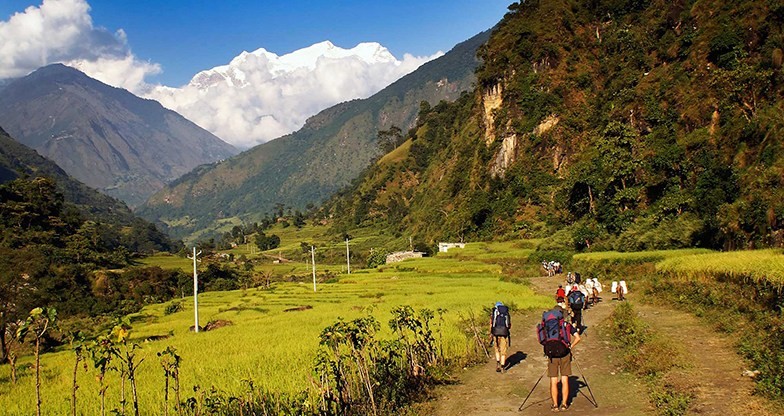

Mera Peak climbing offers an exclusive opportunity to summit the highest trekking peak of Nepal at 6476 meters with excellent views of eight-thousanders like Makalu, Lhotse, Cho Oyu, Kanchenjunga including top of the world Mt. Everest. Mera Peak is one of the most alluring trekking peaks in Nepal as it involves a culturally stimulating journey through remote picturesque villages of our Sherpas and forests, followed by a gentle climb to the summit. Mera Peak is perhaps best known because it is Nepal’s highest trekking peak and successful summits are rewarded with a spectacular panorama of five 8,000m peaks.
Mera Peak via Phaplu nowadays is considered reliable and adventurous trek that leads to the summit of Mera Peak through different routes starting from a lower part of Everest region. This route will allow you to skip the Lukla or any other mountain flight. The return journey includes passing through the ZatravLa pass, allowing for a loop in the trek
Although Mera Peak is very high, the climbing is straightforward. The quickest way to get to Mera Peak is via the Zatrwa La Pass. However, we trek into the mountain via a longer route, which provides better acclimatization. This also takes you off the beaten track and immerses the team in local culture along the way. We have designed our Mera peak itinerary in a professional manner with perfect acclimatization and contingency days. This trip is ideal for those with moderate mountaineering experience, a good level of fitness, and a keen sense of adventure who are not experts but still want to reach the top of a majestic mountain in the Himalayas.
Flexible Itineraries
There are several different routes to reach Mera Peak and the ending point within the lower Khumbu area that engages getting to Mera Peak. The Mera peak itinerary depends on a number of factors including mode of transportation, the route you take, and your time availability. we can craft a good tailored made trip based on how much time you have. You can check our mera peak via Panggom for shorter duration

Trip Highlight
DAY
1
After landing at the Tribhuvan International Airport in Kathmandu and completing your custom formalities pick up your luggage and look for representative of Adventure
Sherpa Tracks who who will be with display board at the arrival gate. You will be greeted by our representative and he/she will pick you and transfer to your hotel. Then check-in at the hotel, freshen up and take a rest. In evening or noon, you are introduced to your guide and discuss about our trip at Hotel where you stay.
DAY
2
Trip preparation in Kathmandu.Today we also get to know our climbing Sherpas and guide as well as fellow climbers. Our climbing Sherpa will will check our equipment(s) to make sure for one last time to get us ready for our adventure. This step will also ensure that if any equipment are missing Overnight in Kathmandu.
DAY
3
Our journey begins with long drive (10-12 hours ) drive from Kathmandu to Phaplu the traditional starting point for treks into the Khumbu region in years gone by. This driving is a little bit long from the Kathmandu. You can see the best view of the green valley. (Optional if you don’t want to drive to Phaplu you can get a short flight from Kathmandu . But the flight to kathmandu is only available for limited days of the
week).Our journey begins with the long drive to Phaplu, the traditional starting point for treks into the Khumbu region in years gone by. From Phaplu we hit the trail for a brief moment hike through forest and along a series of stone steps to Nunthala, our first rest top on
the trek, imagining along the way what it must have been like
DAY
4
Leaving Phaplu early in the morning 4 to 6 hours off road drive takes us to Kharikhola.Today, we turn away from the Everest Trail (which heads uphill to Bupsa and the Khari La). Instead, we head in a south-easterly direction, following a straightforward and at
times zig-zagging trail which gains height steadily and takes us close to Lenjikharka. We reach our overnight halt at the village of Panggom (2850m) in time for a late lunch at our Sherpa’s house. Overnight
DAY
5
We begin our trek after breakfast. After trekking out of Panggom, we cross the
Panggom La pass(Lapcha Danda).The trail descends the rock-strewn path leading to the rhododendron forest. We come across a lot of Mani walls through the trail. Passing again through hills, ridges and teahouses, we start downwards and have lunch around
there in village nearby. Mesmerizing views of the south face of Mera Peak
(6064m/19890ft) and Naulekh Peak awaiting our insight ahead. The trail zigzags through forested areas and then descends steeply. We experience the most interesting and charming feelings as we walk past forests of pine and rhododendron to reach Nigmsa and from here we climb steep part about 45 minutes and we reach Ramailo Danda and overnight
DAY
6
From Ningsow, we climb first then descend for a while and climb some more to reach Ramailo Danda. From here we get extraordinary views of Mera Peak and Salpa. After ascending and descending on our trail, we enter the Makalu Barun National Park. Our
trail from here to Chhatra Khola is called Pasang Lhamu trail. On the way, if we are lucky, we might even come across the elusive Red Panda. Overnight
DAY
7
We walk towards the north on the main trail to Mera Peak. After walking on a trail next to the the Majang Khola, we merge with another trail which moves alongside the Hinku Khola. Our trail moves straight ahead towards Tashing Ongma which has seasonal tea
shops. We continue our trek and cross the bridge over the Sanu Khola before reaching Kothe . Overnight in Kothe.
DAY
8
Today we will enter Barun National Park on this day. Leaving our camp in Khote early in the morning, we will proceed and enter to Barun National Park. The trail leads us along the edge of Hinku Khola in shadow of Mera Peak about 4-5 hours to lead us to Thagnag which will greet us with awe-inspiring views of Thamserku, Kusum Kangru and Kangteka
peaks. we pass a 200-year-old Lungsumgba Gompa where we can find Mera Peak scripted in rock along with its route to reach Mera. Overnight in Thaknak.
DAY
9
Today is an Acclimatization and rest day.Today you can hike around Charpate Himal
Glacier.
DAY
10
Leaving Thaknak, we follow the lateral moraine of Dig Glacier to Dig Kharka, which offers spectacular views of Charpate Himal. The trail climbs through moraines to the snout of the Hinku Nup and Shar glaciers, and then climbs more steeply to Khare. From here, we can see the northern face of Mera Peak which will be an amazing experience.
Overnight at Khare
DAY
11
Today we have a separate day set aside solely for acclimatization and basic training just to prepare ourselves better for the Mera Peak climb. You will receive a pre-climb training from our climbing Sherpa guide on this day. You will get instructions on peak climbing techniques. You will also be taught how to use the climbing gears like ice axe,
crampons, harness and ascender properly. You will learn how to use ropes while you move up and down. So, even an amateur with no prior experience of peak climb can also participate in Mera Peak Climbing. We will head to the top of Mera Glacier and practice using our climbing gears. Later, in the evening we will return to Khare for
overnight stay.
DAY
12
Journey continues along glacier for most of the day. The trail takes us close to the
northern section where there are no crevasses. Mera La stretches south to meet the lofty sweep of Mera glacier which drops down from Mera Peak.From Mera Base Camp, we will walk further on from the High Camp which lies at the
elevation of 5800m. This day presents breathtaking experience of eye-catching views of enormous mountains which is more or less 7000 meters including Makalu (8475m), Everest (8848m), Chamlang (7290m), Baruntse (7220m), Lhotse (8501m) etc. We will also get to see the peaks like Ama Dablam, Kantega, Cho Oyu and more set on the west side. As we get to the High camp (5800m), we will set our camp. Overnight at tented at camp
DAY
13
Our Sherpas will wake you up at about 2 am with hot tea and we all will have a high energy meal before starting the summit ascent of Mera Peak.We will wake up much early on this day. After tea, we will take a slow climb towards the summit. The temperature remains on an average 10 degree Celsius below Zero on this region. We will climb the glacier and proceed to snow hump-back ridge. We will follow the non-
technical and classic route through the south-east ridge. Climbing further through the snout of the glacier, we will climb over the south summit to the summit ridge. Finally, the moment comes for which all of us were eagerly waiting. We will get the 360-degree
views of many eight thousand meter peaks including views of Everest, Kanchenjunga, Makalu, Cho Oyu, Lhotse and other peaks and mountains. We will spend some time on summit witnessing the views before we descend . Later, we ski back back to the high camp where we rest for a while before descending to Khare. Overnight in Khare.
DAY
14
There is no guarantee that we will have favorable weather on our planned day for the summit. Therefore, this day is set aside as a contingency in case we are unable to summit the Mera on the desired day due to bad weather conditions or any other unanticipated reason. However, if the trip goes smoothly, this day will not be required.
DAY
15
Today we trek from Khare to Kothe along the same trail used previously. After reaching Kothe, we celebrate our success by trying out local delicacies and wines. Overnight in Kothe., we celebrate our success by trying out local delicacies and wines. Overnight in
Kothe.
DAY
16
We begin our trek to Thuli Kharka after breakfast. We climb up and descend, cross several tributaries of the Inkhu Khola before reaching a forked trail nearby Taktho. We choose the trail on our right and continue walking. Our trail passes by a Chorten after which we walk downhill on a steep trail. Next, we ascend to Thuli Kharka and pass by
another Chorten on the way. Overnight in Thuli Kharka
DAY
17
We cross the Zatrwa-La pass at 4,600. As soon as we cross the pass, we are welcomed by the sight of the beautiful Lukla Valley which is surrounded by Cho Oyu, Kongde Peak, Numbur Himal, Kusum Khangru and other Himalayan peaks. From Zatrwa La pass we
walk all the way down to Chutang and then straight forward to the Lukla village. In the evening we enjoy dinner in the Himalayas of Nepal with our crew. Overnight in Lukla.
DAY
18
Today, we catch a early morning flight to Kathmandu after our long mountain journey. We can rest and relax throughout the day in Kathmandu at your hotel. Casual day for shopping some gifts home from Nepal for friends and relatives, we can visit to some
nearby shops or venture out in Thamel for authentic Nepalese goods. To celebrate the successful completion of our journey, we will have a farewell dinner in the evening in Kathmandu.Overnight in kathmandu
DAY
19
The reserved day is for any delays in the domestic flight from lukla or for any delays in the mountains. Today, you can spend the day as you please in the Kathmandu and casual day for Shopping around Kathmandu
DAY
20
Your adventure in Nepal comes to an end today! Approximately 3 hours before your scheduled international flight, Our representative from Adventure Sherpa Tracks will drop you off at the Tribhuwan International airport and does a farewell
Trip Start: 2025-04-08
Trip End: 2025-04-25
spots available
Trip Start: 2025-05-06
Trip End: 2025-01-25
spots available
Trip Start: 2025-10-06
Trip End: 2025-10-25
spots available
Trip Start: 2025-11-03
Trip End: 2025-11-21
spots available
Having the right equipment on your adventure trips will make almost as much difference to your success, safety, comfort, and enjoyment as any physical training you do. It is essential that you take the time to acquire the correct gear; don’t wait for the last minute to find out your local shop doesn’t have your size. This equipment is expensive, but you can often find great sales online and at your local gear store. The purpose of this gear list is to help guide your purchases.
This list is a guide. While you are required to bring everything on this list, there are numerous options, brands, and versions of each piece of equipment, unless otherwise noted. Using our current suggested brand list we encourage you to shop around, do research, use your experience and the listed features to find the best gear for you.
During your time in the mountains, you will encounter a very wide range of temperatures and weather conditions. At one end of this range is the pleasantly warm and beautiful low land, while at the other end of the spectrum is found the cold and often windy weather of the highest peaks in the world. The equipment you bring must function well in a wide variety of conditions. Your clothing should be warm, lightweight, dry quickly, and allow good freedom of movement. The layering principle, based on several thin layers of insulation
(rather than one thick one), covered with an outer weatherproof shell, meets these needs well.
A Note on Packing
For your international flights, we recommend that you pack all your equipment in your two duffle bags. Do not simply pack your backpack (since the straps can be damaged by the baggage handling machines). It is important to lock these bags for their trip. Depending on the airport, you may be able to put your travel locks on after TSA has searched the bags. If not, Lock the bags with Zip Ties. If the TSA cuts off the zip-tie to search your bag, they will replace it. You will still need the travel locks to lock your bags in the hotel and during the expedition. Generally, you will take one duffel up to Base Camp, and leave one in the hotel in Kathmandu with your belongings for your time in the city. Your trek in duffel will only be accessible in the evenings (with items such as changes of clothing, sleeping bag), and your day pack will hold vitals such as water, layering, blister kit, and camera.
Important Notes:
Tips:
Clothing
Footwear
Handwear
Headwear
Climbing Gears
Backpacking
Accessories
Hygiene and first aid
Others
Conclusion:
As the weather condition is unpredictable in the Himalayan region, you need to be prepared at all times. A day can start sunny with clear skies and later become cold and windy at the high altitudes.
Sometimes, it can rain and snow during the trekking period. You need to remember that for a successful trekking journey, your physical comfort must be the first priority.
Note:
Please note that these items listed above will vary according to the season, trek duration. Please remember that your luggage will be carried by the porter, but you need to carry a daypack on your own. We also suggest you pack only necessary items to keep the weight of your equipment to a minimum. Carrying a day pack only applies to the trekkers who take full package with us and those who take only guide they should bring the bag big enough to carry their own stuff. If you have any questions, please do not hesitate to contact us at your convenience.
1
Climbing Mera peak itself is not very technical and doesn't consist of a steep technical climb but the high altitude reaching 6461m at the summit makes this a challenging climb. Unlike other trekking peaks in Nepal, the climb to Mera peak is straightforward.
2
We recommend climbing Mera Peak in late April, May, late September, October, and November. We find that when we climb on Mera Peak, generally the best months are May and October. If you decide to climb in late March, early April or late October into November, you need to be ready for colder conditions.
3
There are several peaks, and among them, Mera Peak is one of them. It provides the view of five 8000 er including Everest. The peak gives a close-up view of Mount Everest, Cho Oyu, Makalu, Kanchenjunga, and Lhotse


